Whether you’re preparing for NTA UGC NET/JRF, MBBS, NEET-PG, or any entrance medical exam, you can’t afford to pick the wrong Forensic Medicine and Toxicology book.
Why??? Because Forensic Medicine is a vast topic, so is the book. On average, a forensic medicine and toxicology book is around 500 pages.
So, if you pick a forensic medicine book that is not in-depth or well written, then it not only costs you precious time but you fail to acquire that much information that you needed to crack your exam.
However, this scenario will be different if you have limited time to prepare.
P.S. I am not saying a book “can be wrong”. I only mean to say that it is not right for you as a beginner. Otherwise, if you prior read the forensic medicine books then you can pick any of the listed books—all of them are best.
So, this post is only for the students who are willing to read forensic medicine as a whole, for the first time.
As the majority of forensic medicine books are coupled with forensic toxicology, so we are going to cover the best forensic medicine and toxicology books for NTA UGC NET/JRF, MBBS, NEET, PGI, JIPMER, DNB, BHU, KCET, MAHE, or other undergraduate and postgraduate exams.
List of Best Forensic Medicine and Toxicology Books
There are a total of 5+1 books on this list.
The first five books are especially for UGC NET, MBBS, NEET preparation. Conversely, to the last book, it is for those aspirants who have limited time, say 1 month or less, to their exams.
#1 Textbook of Forensic Medicine and Toxicology by Anil Aggrawal
Packed with gems….It is one of the most detailed book on forensic medicine and toxicology which is well written with factual information.
Moreover, it was one of the books that I read for the preparation for NTA UGC NET.
This is the image of the book that I have. (Sorry for the background)
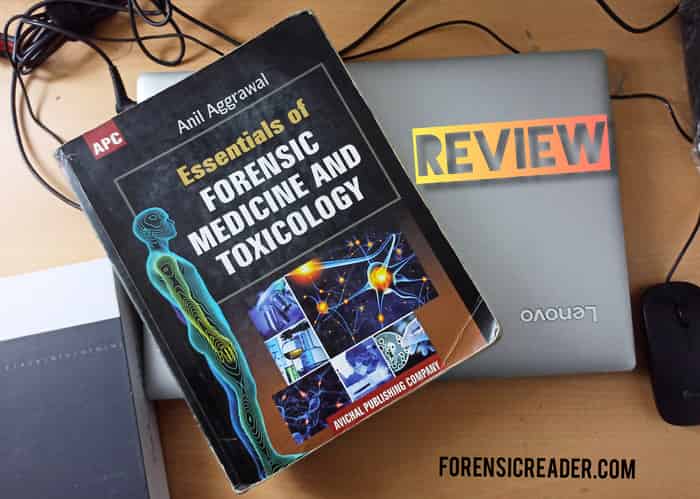
The above book is the first edition. But for this comparative listing, I also used the free kindle edition of the latest edition of this forensic medicine book.
Now let’s look at How Anil Aggrawal’s forensic Medicine book is organized.
How Anil Aggrawal’s Forensic Medicine And Toxicology book is Organised?
At first, it is colorful and the information is well organized in a concise manner that facilitates a clear understanding of the topics.
This also helps you to learn systematically and with ease.
A. Heading Distribution
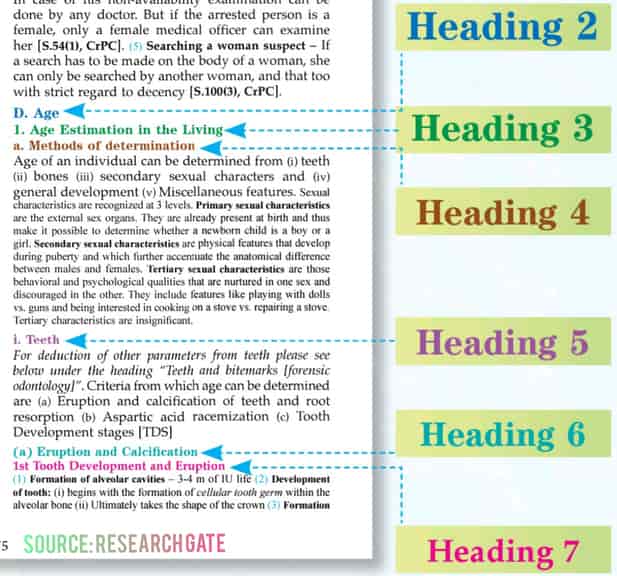
While talking about the book structure, each topic is divided into subtopics and further branched into more subtopics with the help of hierarchy heading distribution (H1, H2…..H7).
The book has up to H7-level of heading.
B. Smaller Font Text
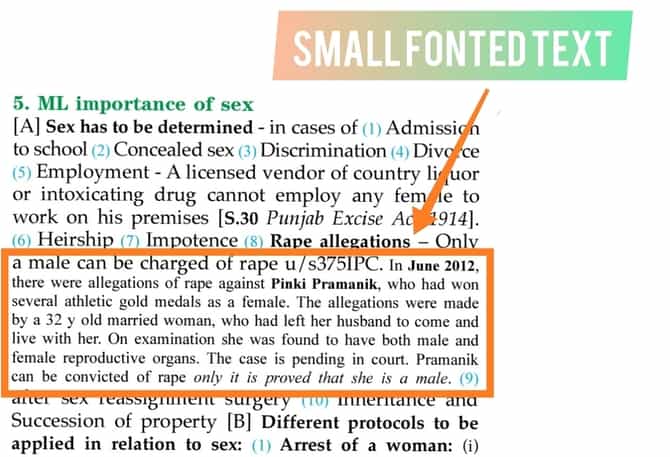
The books have bolded smaller-fronted words that majorly states:
- Examples related to the topic
- Explanation of topics
- Side notes
- History and origin
- Important characteristics
C. Blue Pointers and Numbering Levels
Within the heading, information are listed in the paragraphed pointer of blue color (also seen in the above image)
This makes learning visually easy and understandable.
These blue pointers create easily scannable paragraphs without making your eyes get bored with long paragraphs that are common with other forensic medicine books.
In addition, it cuts your crucial revision time by more than half.
D. Memory Aids and Mnemonics
When you are dealing with tons of knowledge, you need a system (or develop patterns) to learn faster.
And this is where this book gets more helpful.
Almost, each chapter has a memory aids section. These small boxes are used by the author to narrate more information related to the specific topic.
On the other hand, you will also get mnemonics for various topics.
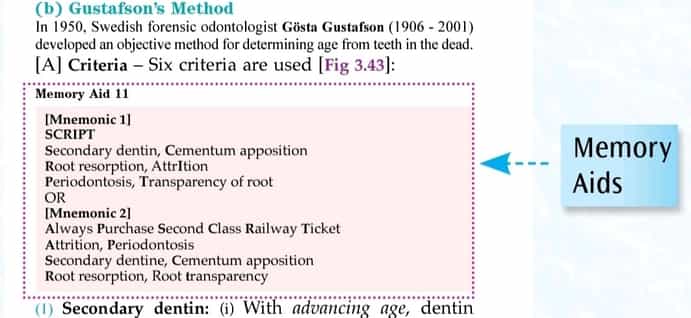
The book that I’ve, has a total of 197 Memory Aids and Mnemonics.
With all these memory aids and mnemonics, your learning will be more effective, especially when you have clumps of data.
It also permits your memory to remember more and efficiently.
E. Color Picture, Photographs, and Line Diagrams
The full book is printed with color ink on high-quality paper.
The photographs and infographics are impressively captioned with the necessary explanation.
Moreover, in a chapter like injuries, there are line diagrams to present the most detailed observation and parameters of the injuries.
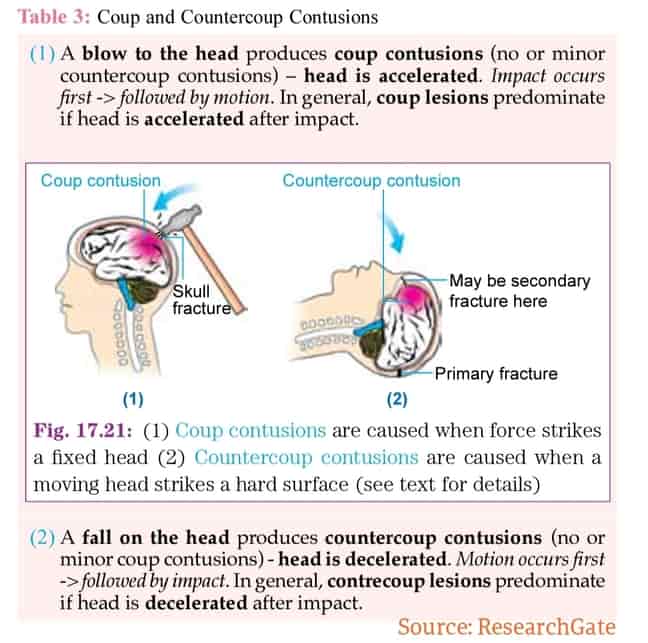
Plus, some pictures show the microscopic (or lower-scaled) images into observable-bigger images.
F. Flow Charts
For defining various step-by-step guides or a certain set of steps, flow charts are there for you.
These flow charts are filled with a set of colors that graphically represent different elements of a process.
This also helps you, as a first-time reader, to understand the interrelation and sequence of occurrence in the process.
What’s Inside in Anil Aggrawal’s Forensic Medicine and Toxicology Book?
Section A: Forensic Medicine
The Forensic Medicine Section of Anil Aggrawal’s book has a total of 30 chapters that are divided into 7 sections.
This included some non-obvious chapters such as:
- Mass Disaster
- Forensic Science Laboratory
This section is full of tables and illustrated pictures that are fairly helpful to remember and understand.
B. Forensic Toxicology Section
5 sections and a total of 17 chapters that what you get in Anil Aggrawal’s medicine book.
In this section, I find one more helpful element i.e. tests for detection.
All the laboratory tests are presented in a listed form with clear pointers to define the procedure and possible +ve or -ve result.
Final Verdict
Personally, I’m in love with this book. That doesn’t mean there are no demerits in it.
This book is loaded with information. But what is lacking most is, “there is no questionnaire or MCQs” after the chapters to test your knowledge.
Otherwise, this is just perfect, and this is what makes it one of the best books on Forensic Medicine and Toxicology for the preparation of UGC NET Forensic Science, MBBS, NEET-PG, and other medical exams.
Also Read:
- How to Prepare for NTA UGC NET/JRF Forensic Science Paper 2?
- Previous 16 Year Question Paper Solved MCQs UGC NET
- Draughtsman Appearance: Colonies Structure & Morphology
#2 Review of Forensic Medicine and Toxicology by Biswas Gautam
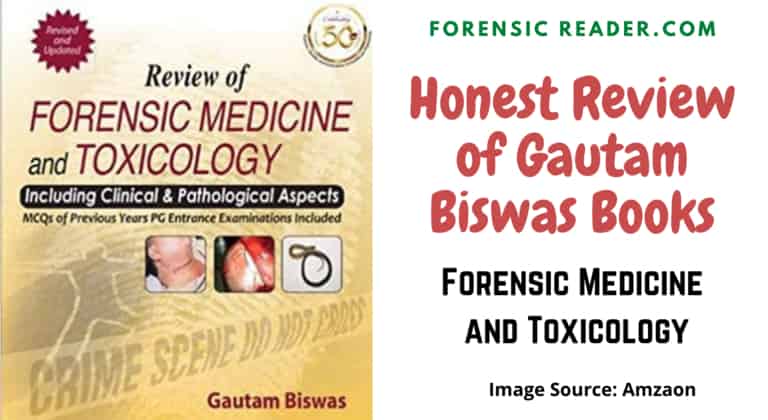
You shouldn’t judge a book by its cover. Sounds familiar?
Forensic Medicine and Toxicology book by Gautam Biswas is one of the underestimated and not-so-popular book.
The book itself is a whole package that makes you cry with joy.
You are even amazed by the depth of knowledge that you get from it.
More importantly, you don’t have to buy separate MCQ books for the medicine and toxicology section.
Honestly, it is the book that gives a neck-to-neck fight with Aggrawal’s Forensic Medicine book.
Though the book is not that detailed-oriented as Anil Aggrawal’s but you will get as much knowledge (even more) from reading any other forensic medicine and toxicology book.
Here, as stated earlier, you will get a dedicated MCQs list at the end of each chapter.
How Gautam Biswas’s Forensic Medicine and Toxicology Book is Organised?
When you look at the front page of the book, it looks like an ordinary book.
The book cover is simple and boring.
But the best part, we don’t have to do anything with its cover.
The magic is inside the book.
At first, of course, you will get a table of the content page. The content page, itself is very uncommon and detailed.
The very next page after the table of content is the one-page history of the development of forensic medicine over time.
Please Note: All the pointers listed here are from the 3rd edition of the Gautam Biswas book. I don’t have the 4th edition right now but soon I would update the minor changes that are in its latest 4th edition.
A. Heading Distribution
All the major heading are backgrounded with black color along with the white text.
Each major heading is then followed by bolded black fonted subheadings. These subheadings are usually numbered or bullet-pointed into a neat list.
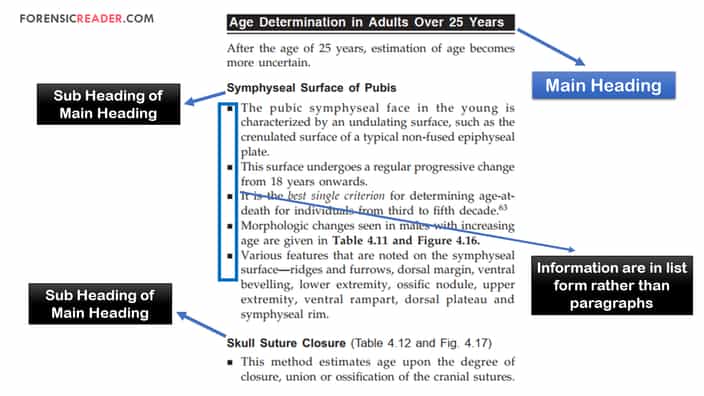
Unlike Anil Aggrawals, the Biswas book of forensic medicine and toxicology has a standard font size for all the text under a heading.
B. Smart Boxes
The book is full of smart boxes that let you get more understandability towards certain topics. In most cases, these boxes educate you with:
- More information about the topic
- Factual data
- Define uncommon terms
- State case studies
- Interesting facts and history
- New advancement to topics
- Certain test and their procedure
C. Infographics and Pictures

The first section of the book, i.e. forensic medicine, has a bulk of designed images that give a practical understanding of the picture’s content.
These images are well-labeled with their respective information and captions.
While, in the forensic toxicology section of this book, images are colorful that bind all the structural components clearly.
Most of the images have dedicated explanations that illustrate the picture’s information.
D. Flow Charts and Tables

You never grasp fast information from a set of procedures as compared to flow charts. These graphical representations not only make you learn faster but also helpful in better rememberization.
The book has ample of them.
While talking about the tables, they have one of the most accurate tabulated data.
What’s the best? You can totally rely on that.
P.S. All the books in this list have tables on which you can rely. But in Anil Aggrawls and Biswas’s book, you will get more tables than any other book (as per today’s knowledge). Moreover, I can’t state the exact number of tables as I don’t count them, but both have almost equal numbers of tables.
E. Enriched MCQ Sections
The thing that separates this book from others is its enriched MCQ section.
The MCQ section lets the aspirants in developing critical thinking about the topic.
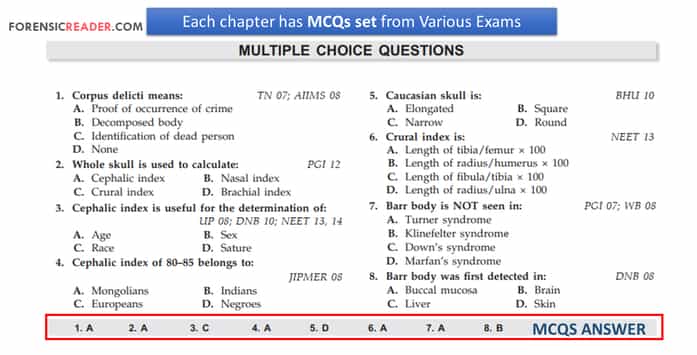
In addition, all the MCQs are arranged in chapters and each one of the chapters has them.
The frequency of these MCQs varies from chapter to chapter.
More importantly, for any competitive exam, you have to engage with solving MCQs as much as possible. For that, you don’t have to buy a separate MCQ book for forensic medicine.
All you need to do is to invest in Gautam Biswas’s book of Review of Forensic Medicine and Toxicology.
F. Question Bank
Preparing for a subjective exam? Get Biswas’s Review of Forensic medicine and toxicology book.
The book has a separate question bank section.
All the questions and important topics are arranged chapter-wise that further ease your learning while solving them.
In addition, there is a “Desirable to Know” section— as a rectangular box— in each chapter that defines important topics in the form of the list.
What’s Inside in Gautam Biswas Review of Forensic Medicine & Toxicology Book?
Section A: Forensic Medicine Section
This section has 35 chapters that make it the most numbered chapter book in our list of best forensic medicine and toxicology books in the forensic medicine section.
The book has all the chapters that you would find in Anil Aggrawal’s book of medicine and toxicology.
However, here you will get some extra chapters. These are:
- DNA fingerprinting
- Torture and Custodial Death
- Medico-legal Aspects of HIV
- Newer Techniques and Recent Advances
The chapter “Newer Techniques and Recent Advances” listed down the detailing on the polygraph, brain fingerprinting, and narco-analysis.
B. Forensic Toxicology Section
There are a total of 28 toxicology chapters.
At first, you will find that there is too much content than Anil Aggrawal, but more or less, topics are almost the same.
In this book, some topics are stretched to chapters that lead to a total of 28 chapters.
Important tips, extra info, tests, recent development, and additional knowledge packs are represented in the grey color boxes.
Final Verdict
The book is as awesome as Anil Aggrawals. And in some way, it even beats all other forensic medicine and toxicology books.
This is one of the best and most recommended books that I would consider for your competitive exam preparation.
Some demerits are:
- It doesn’t have memory aids and mnemonics like Anil Aggrawal.
- Lack of explanatory examples, especially in legal and judicial chapters such as various sections of IPC, CrPC, etc.
But it can compensate with its question bank and MCQ series.
Honestly, they are very helpful for getting to know how much you grasp the topic.
If you ask me which should I buy, Anil Aggrawal or Gautam Biswas? I would say, buy Biswas if you don’t want to buy additional MCQs book for practice. Otherwise, go with Anil Aggrawal.
P.S. We are planning to give you one to one comparison among Biswas’s, Aggrawal’s, and Pillay’s Forensic Medicine and Toxicology book. But for that, you have to wait for a while.
#3 The Essentials of Forensic Medicine and Toxicology by K.S. Narayan Reddy and O.P. Murty
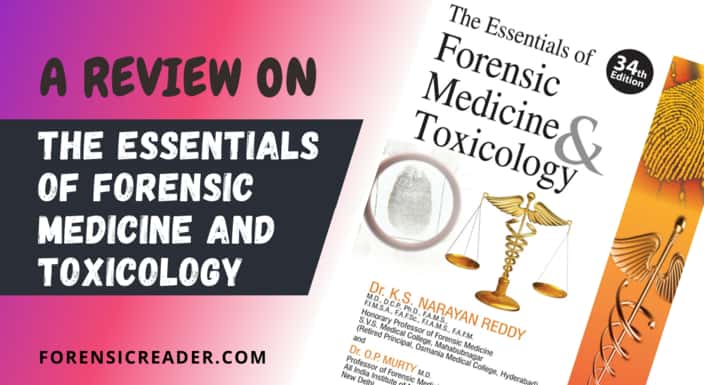
Forensic Medicine and Toxicology by Reddy and Murty is definitely the most common name you heard when it comes to Forensic Medicine and Toxicology book.
Like Anil Aggrawal’s and Biswas’s book, you can duly trust the information provided in this book.
It is one of the books that is most trusted by the many of years among students and aspirants of the various medical exams.
Now, if you really want to build some of the best and most solid concepts in forensic medicine and toxicology, this book is worth giving a try.
How Reddy’s Forensic Medicine and Toxicology Book is Organized?
This book is very vast. It resembles a giant piece of word blocks.
And I personally, don’t like their data representation and paragraph distribution.
To me, it looks like a big paragraphs block with no proper paragraph spacing.
If you observe, unintentionally, some pages with no picture, all pages look the same.
This makes it quite boring.
But trust me, if you go through all of these topics, you definitely have an edge over other aspirants.
Moreover, if you compare the content side by side with the other above two books, you will only find differences in terms of their organizing structure.
A. Heading Distribution
Though all books have comparable content like the other two, but what makes the difference is, the book is formulated in a bluish theme followed by bolder black subheadings.
Book’s main heading has a blue color.
In a sprite of blue color, each and every element of the book is printed in black.
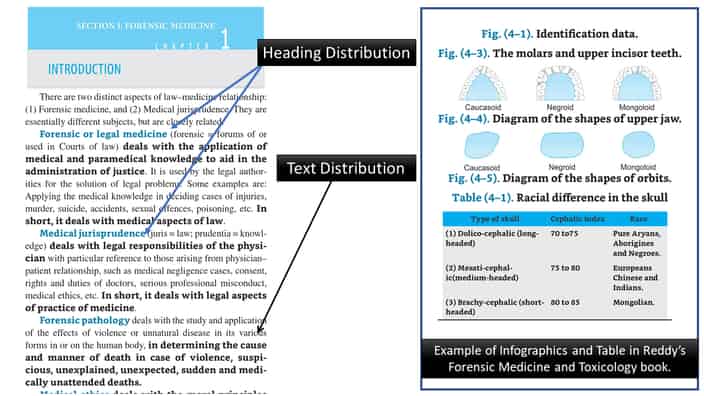
For important notes or examples, the bold-black color code is used. While the simple text is universally faint black color.
B. Infographics and Pictures
Majority of illustrator images are grey with a blue background color. They do their job of giving you additional information related to the topic.
Moreover, images are not pretty but, they have impressive detailing.
C. Tables and Flow Charts
Here this forensic medicine and toxicology book falls behind.
The author prefers paragraphed phases over tables, that’s what I see.
Let’s see this example. Image A is from Reddy, and Image B is from Gautam Biswas.

Gautam Biswas forensic medicine book formulated the information in a flow chart and list pointer, that helps you to quickly grasp the concept.
Conversely, there are also advantages to it. The paragraphed information by Reddy is more detail-oriented than Gautam Biswas’s medicine book.
In another example, a chapter on the topic of asphyxia. In Anil Aggrawal’s and Biswas’s books, you will find flowcharts and tabulated information related to hanging.
But, I only find a single table in this section of Reddy’s forensic medicine and toxicology book (in 33rd edition).
What’s Inside Reddy’s Forensic Medicine & Toxicology Book?
Section A: Forensic Medicine
23 Chapters that are what you get in the forensic medicine section of the books.
All these chapters are packed with good pieces of information. You are going to love it when you’re going to make your notes.
Chapter 4: Identification, is one the most detailed chapters that you get in this list of the best forensic medicine and toxicology books. The image illustrators especially the ossification tables are damn good.
At the same time, there is too much in-depth knowledge that you get from this book.
It is just like a force.
You will be fed-up soon with that much information in the 4th chapter itself. So, better makes your notes side-by-side.
Section B: Forensic Toxicology
Number of chapters: 15.
The information that is here will not disappoint you. Though it is hard to read and grasp information at a fast rate, it is only for the first time.
Moreover, even the toxicology section doesn’t have frequent tables for various characteristic observations.
They all are curated in the paragraphs.
However, you will find few important tables that aid your process of learning.
Final Verdict
The book is one of the cheapest books for Forensic Medicine and Toxicology.
It doesn’t mean you can’t rely on the information.
On the dot, the information is reliable and trustworthy.
The book also has a short number of chapters, not the information. I am not saying Reddy’s book has a lack of information, but my point of saying is the information is stretched in paragraphs.
They are good for the note makers, but not good for the people whose goal is to finish forensic medicine in one or two months.
If the book has a more tabulate summary of their paragraphed text, it would become more scannable and easy to digest.
But the sad part, it doesn’t.
Other than this, the book doesn’t have any questionnaires and MCQs to test your knowledge.
Also Read:
- Most Famous Forensic Anthropologist With Their Achievements and Discoveries
- 12 Most Famous Forensic Pathologist: Achievements and Discoveries
- Paltauf Hemorrhage: Causes, Symptoms [Forensic Medicine]
- Age Estimation From Teeth: All Forensic Odontology Tables Included
#4 Parikh’s Textbook Of Medical Jurisprudence Forensic Medicine And Toxicology By B.V. Subrahmanyam
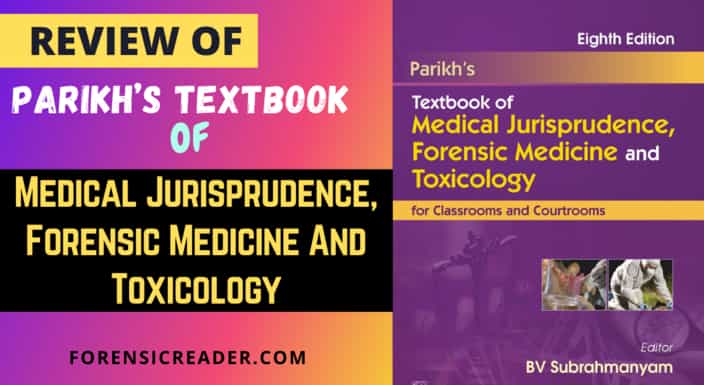
Searching for Question-Based learning? Think Subrahmanyam book of Textbook of Medical Jurisprudence, Forensic Medicine and Toxicology.
The book is sort of classic too.
Book is outlined in a neat and very scannable format. Images are also too neat, glossy, and detailed.
And some books like this squeaked out all the texted intelligence that you needed for your preparation—whether NTA UGC NET Forensic Science or MBBS or NEET PG— in an understanding and meaningful way.
How Subrahmanyam’s Medical Jurisprudence, Forensic Medicine, and Toxicology Book is Organised?
The first impression of the book’s page is stunning. It is well-structured with a readable font size.
Lines, paragraphs, and columns are equally spaced.
Even the writing on images shares the same font size.
I would say, the author and editors have done a quite reasonable job at addressing the small elements of the book.
The table of content is divided into different sections which are further distributed with subheadings along with respective page numbers.
They have the most detailed Table of Content page.
It is so detailed that you don’t need a glossary page to find a specific topic in the book.
A. Questionnaires and Heading Distribution
Chapters are hammered down into question i.e. all the topics are constructed into questionnaires.
The questionnaires have bolded dark red color.
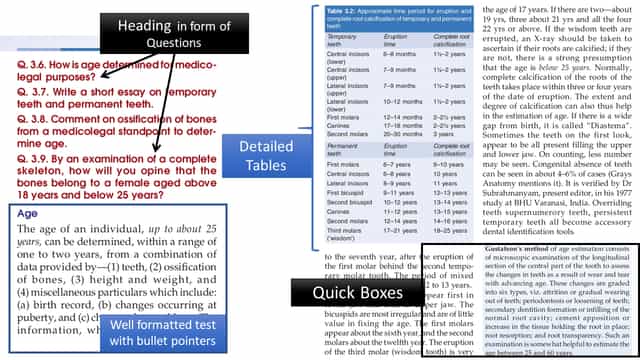
This gives you some sort of preliminary curling about what types of questions might be asked in your subjective examinations, if any.
In each set of questions, they have respective sub-heading of navy blue along with tabulated and untabulated boxes.
B. Tables and Quick Boxes
The book has a decent amount of information that is instructed in tabulated form followed by the paragraphed text.
The tables are molded in a blue tinge with proper heading.
Tables are well formulated to give you one of the most accurate values in a simple form.
While talking about non-tabulated boxes, they state important variables, tests, observations, and further reading text.
C. Pictures and Infographics
They are quite clear. If you’re a fan of glossy pictures, you will love this book.
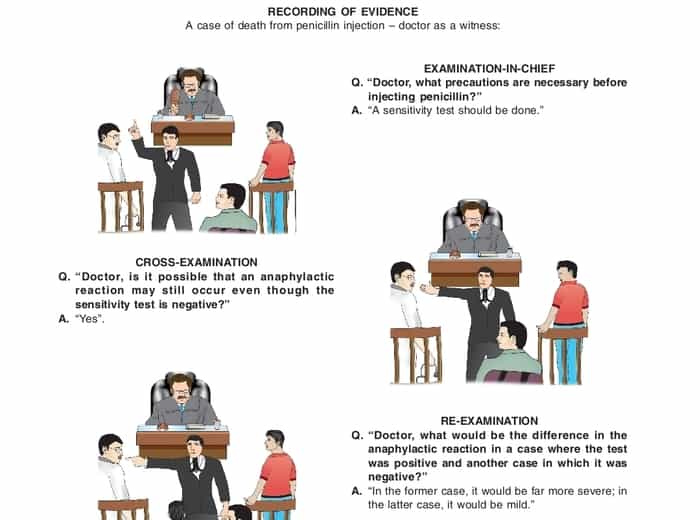
In addition, there are not too many infographics like other forensic medicine and toxicology books but the captioned text, below the images, presents the most crucial features in a very crisp and concise manner.
Here, images are crisp and clear but they are outnumbered as compared to Reddy’s book of forensic medicine and toxicology.
What’s Inside in Subrahamnayam’s Textbook of Medical Jurisprudence Forensic Medicine And Toxicology?
Section A: Forensic Medicine
There are a total of 7 sections that are further divided into 35 chapters.
Most of the topics are the same as what you get from other forensic medicine and toxicology books.
But on a close look, I find a topic that I think no other medicine book has. The topic is Dr. Subrahmanyam’s “Namaste’ Technique.
Dr. Subrahmanyam’s “Namaste’ Technique is useful in case of decomposed and crushed hands up to the wrist level. For more information, you can easily read it on page 73 of the book.
In addition, another unique term called “Cat Deaths” or SIDS along with topics such as body farming, virtual autopsy, and narco analysis is added in this edition.
Other topics that are added in this edition are:
- Recent changes in the criminal law related to sexual assaults, sexual deviations, and acid attacks.
- Protection of Children from Sexual Offences Act, 2012.
Section B: Forensic Toxicology
With 5 sections and their subsequent 32 chapters, you will be going to get detailed information that you needed for your exam preparation.
There are fewer new topics that are added in this edition, listed as:
- Hair dye poisoning
- Brassinolide poisoning (plant poison)
- Khat abuse
Final Verdict
Subrahamnayam’s textbook of Medical Jurisprudence Forensic Medicine And Toxicology, no doubt, is one of the considerable books for your preparation of forensic medicine.
The book is consistent with its newer editions (currently 8th) and added major changes that you need to know related to certain crimes.
The book also states some uncommon and unique topics that may be an important source of information for various competitive exams.
However, there is one drawback that you should consider before buying it. Such as it has fewer infographics as compared to other books in this list.
So, if you can cope with it, it would definitely be a wiser choice to have it on your studying desk.
It is simple. Artistically structured and well-fonted.
For me, this book is well-defined and structured as compared to Reddy’s book. But, after all, it’s my personal preference.
#5 Textbook of Forensic Medicine & Toxicology by V. V. Pillay
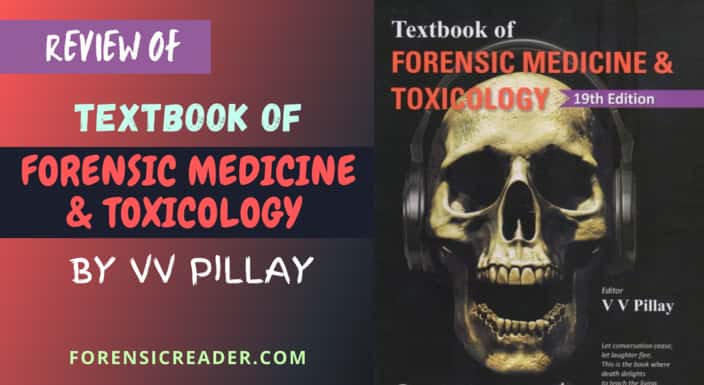
Beautiful means ‘full of beauty’— suited best on Pillay’s Textbook of Forensic Medicine and Toxicology.
The book’s pages are drawn with a smoothness that is hinged by a hardcover, decorated with enlightening quotes.
The term ‘full of beauty’, is not about the smoothness of pages or the beautifully designed pages or even about its structure writing, it’s all about the beauty that resists in its core.
So, for the first time, I am going to state a forensic medicine and toxicology book with the term “Snazzy Medicinal” novel.
The information presented in the book is not like others. Here, information is subjective rather than being objective.
Author melds the information to make forensic medicine interesting— at least he tried it successfully.
And honestly, he did a great job in doing so.
Some of the highlighter pointer that you will not be going to get anywhere else (not as per my knowledge):
- Storytelling. A way of telling a story that is so deep and detailed that you never forget it.
- Small detailing. Whether it is bringing the image from the history to state the little extra information or adding a pronouncing facsimile that no other author wailed to add in their books.
How Pillay’s Textbook of Forensic Medicine & Toxicology is Organised?
Pillay’s book is as good as Anil Aggrawal’s Forensic medicine and toxicology book.
As I don’t have a real book for the in-depth comparison, I couldn’t give you too much information here.
But, I will cover it soon and update this list.
Conversely, in this 19th edition, there are 40 chapters:
- Forensic Medicine Section: 25 chapters
- Forensic Toxicology Section: 15 chapters
In addition, there are five extra annexures for further reading.
Like Biswas’ book of forensic medicine and toxicology, Pillay’s book also has some extra-non-common chapters, including:
- Crime Scene Investigation
- Trace Evidence
- Forensic DNA Typing
- Recent Advances in Forensic Science
- History and Development of Forensic Medicine
There is nothing that I have to add here.
Final Verdict
I am pretty sure, NO other book beats it when it comes to detailing along with improvised helpful ways of presenting the information.
The book is gowned with pretty much every information, explanation, story, and image that you need for your exam preparation.
P.S. I don’t have this book. All the information is presented in this section, I dug that from amazon images of the book.
But all the things that I had stated about this book, are as true as Locard’s exchange principle.
And I promised you, I’m going to update this list soon after I get this masterpiece in my hands. Till then, be my guest and read the rest of the post.
#6 Forensic Medicine Nothing Beyond For PGMEE by J. Magendran
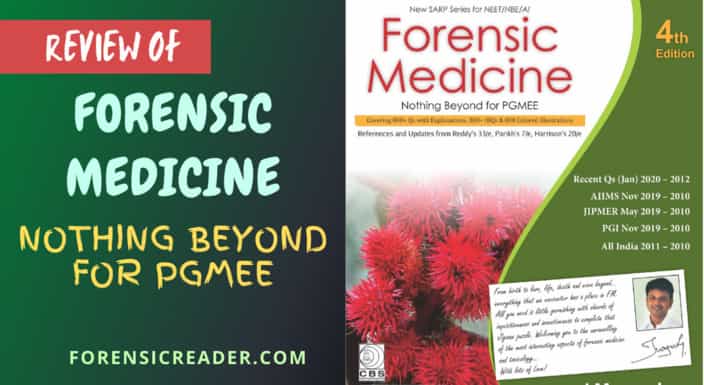
Only half— or even less than half— the number of pages that other books have.
Still, this book manages to make it in this list of best Forensic medicine and toxicology books for the preparation of NTA UGC NET, AIIMS, NEET, PGI, JIPMER, DNB, BHU, KCET, MAHE, or other undergraduate and postgraduate exams.
I deliberately added this short book to this list.
Why??? Because it is for those aspirants that have limited time for preparation for their exam. Or wanting something that makes revision smoother.
The book is outlined in a very clear-cut manner.
It only indulges the important pointers.
As it is half the average number of pages, there is no way Magendran’s Forensic medicine book will give you that much subjective literature on topics as other books do.
Therefore, you can say that this Forensic medicine and toxicology book is not paragraphed literature oriented, but bullet pointers oriented.
This would cut your reading time to many folds and ease you at revision.
What’s Inside in Mahendran’s Forensic Medicine Book?
I tried the first chapter of this book. It is just simple yet detailed enough that you never miss any concept.
Moreover, the cost of the book is around 400/- (kindle edition). So, you can consider it to be the most cost-effective book on this list.
Now, let’s go back to the book itself.
It has a total of 11 chapters including forensic toxicology. It sounds outnumbered but surprisingly most of the topics get covered in it.
A. Design and Layouts
A single page consists of too much information that is categorized or sorted in pointers or tables.
You can also get Mnemonic for various terms along with other important tables.
This is how a single page of Magendara’s Forensic medicine book looks like.
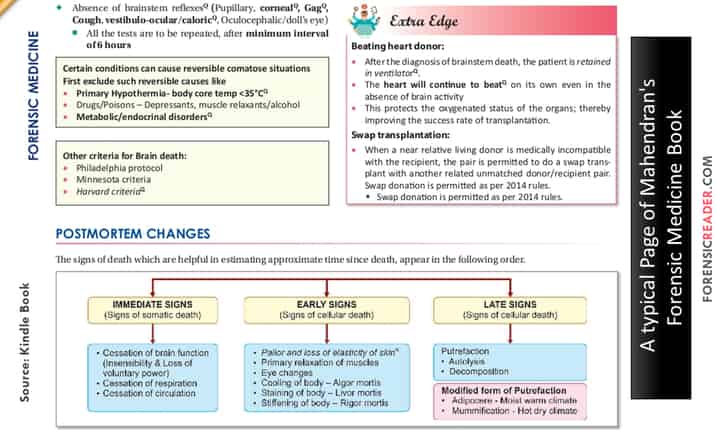
The above page, consist of, not restricted to:
- Definition with mechanism
- Mnemonic
- Listed pointers
- Illustrative boxes and Extra edge with other details
- Tabulated differentiation
- Flow charts for fluent learning
- Respective question
- Bolded text for highlighted text.
B. MCQs And Frequently Asked Section
Each chapter has dedicated MCQs and a Frequently asked section. This will further harden your concept so that there is no space for confusion.
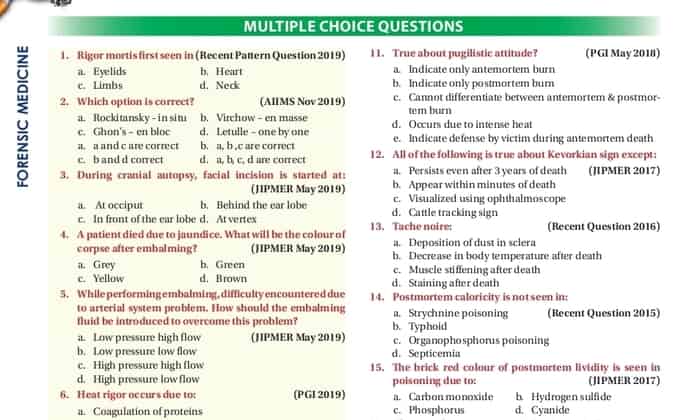
MCQs are not only restricted to text form but here you will find image-based MCQs.
And in the end, there is an answer and explanation section for each of the MCQs questions that were asked to you.
Final Verdict
Undoubtedly, this book is not in-depth but if you have a very limited time then go with this book.
So, you can say that this is helpful for preparing for any undergraduate and postgraduate exam when you have less time say, 1 to 2 months.
This is the same reason why you can’t consider this book as the primary book for your in-depth preparation for NTA UGC NET or NEET or AIIMS exam.
But it could be proved to be the best second-cum-revision book, especially, when you are not making notes of yourself.
Let’s End This
You have got to be kidding me? I’m still confused, what to buy.
If you still have thoughts like this even after this long detailed article, then these are the quick summary that helps you in getting the best forensic medicine and toxicology book for you.
Best Book for Forensic Medicine and Toxicology for NTA UGC NET/JRF Forensic Science
- Preference #1: Review of Forensic Medicine and Toxicology by Gautam Biswas
- Preference #2: Anil Aggrawal’s Book of Forensic Medicine and Toxicology
- Preference #3: Pillay’s Textbook of Forensic Medicine and Toxicology
Best Forensic Medicine and Toxicology for MBBS, NEET, PGI, JIPMER, DNB, BHU, and Other Entrance Exam
- Preference #1: Pillay’s Textbook of Forensic Medicine and Toxicology
- Preference #2: Review of Forensic Medicine and Toxicology by Gautam Biswas
- Preference #3: Anil Aggrawal’s Book of Forensic Medicine and Toxicology
Best Book of Forensic Medicine and Toxicology For In-depth Learners
- Preference #1: Anil Aggrawal’s Book of Forensic Medicine and Toxicology
- Preference #2: Pillay’s Textbook of Forensic Medicine and Toxicology
- Preference #3: The Essentials of Forensic Medicine and Toxicology by K.S. Narayan Reddy and O.P. Murty
Best Forensic Medicine and Toxicology Book for Last-Time Learners
- Preference #1: Forensic Medicine Nothing Beyond For PGMEE by J. Magendran
- Preference #2: Review of Forensic Medicine and Toxicology by Gautam Biswas
- Preference #3: Parikh’s Textbook Of Medical Jurisprudence, Forensic Medicine And Toxicology By B.V. Subrahmanyam
Best Non-Boring Book of Forensic Medicine and Toxicology
- Preference #1: Pillay’s Textbook of Forensic Medicine and Toxicology
- Preference #2: Forensic Medicine Nothing Beyond For PGMEE by J. Magendran
- Preference #3: Review of Forensic Medicine and Toxicology by Gautam Biswas
Now, I hope you fall, at least, in one of the above categories.
Before finalizing this article on the 6 most famous and best Forensic Medicine and Toxicology books that justify their pricing, here are some frequently asked questions that further aid you in buying your first and right book.
Frequently Asked Questions
1. Which is the best forensic medicine book for MBBS and NEET PG exams?
Ans. As I guess, if you have enough time for the preparation, go with Pillay’s Textbook of Forensic Medicine and Toxicology. And if you have one month or less, you can suit to Forensic Medicine Nothing Beyond For PGMEE by J. Magendran. Another alternative to Pillay’s book is Anil Aggrawal’s Book of Forensic Medicine and Toxicology.
2. I have limited time, say 1 month or less for the exam, which book should I go with?
Ans. As you don’t have enough time, and I guess you’re reading forensic medicine for the first time, it is better to consider Mahendran’s Forensic Medicine book.
3. Which is the best forensic medicine and toxicology book for NTA UGC NET Exam?
Ans. No doubt, go with Biswas’s Review of Forensic Medicine and Toxicology book. You even don’t have to buy a separate MCQ book. It helps a lot in preparation. It is one of the top recommended books for any competitive medical exam.
4. What are some tips for studying Forensic Medicine and Toxicology books?
Ans. I don’t know the perfect way of studying it. But I will give you how I had studied forensic medicine and toxicology. These are:
-> First, stick to note-making habits.
-> Use color highlighters to color-down specific observations and details.
-> Learn all tables first, without skipping anyone.
->Test your knowledge that you get from the table. Try to replicate tables at least 5-6 times, at different stages of your revision.
-> Make patterns while learning tables. This will help you in better remembrance.
-> Solve MCQs side by side.
-> Buy a separate MCQ book if you don’t have Biswas’s or Mahendran’s Forensic Medicine Book.
If you’re preparing for NTA UGC NET Forensic Science, check out the step-by-step guide on How to prepare for Forensic NTA UGC NET/JRF exam.
Do you have any other tips you think I should have mentioned? Let me know in the comments!

FR Author Group at ForensicReader is a team of Forensic experts and scholars having B.Sc, M.Sc, or Doctorate( Ph.D.) degrees in Forensic Science. We published on topics on fingerprints, questioned documents, forensic medicine, toxicology, physical evidence, and related case studies. Know More.

One of the best, most detailed, unbiased true assessment of the 6 main books. As I read through the description, I was amazed to see how parallel your thoughts were to that of mine. This review sounded almost as if I wrote it. My guess is you are no ordinary student. Most probably an experienced faculty. Prove me wrong
Thanks for reading me. I never thought you ever going to read this review post. It is terribly long. I read your book for my forensic postgraduate and NTA UGC NET preparation. And for this review, I just try to be honest and all detailing comes naturally. Lastly, I am just an ordinary postgraduate student.